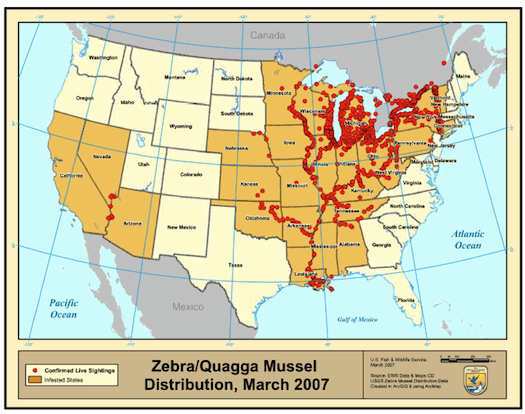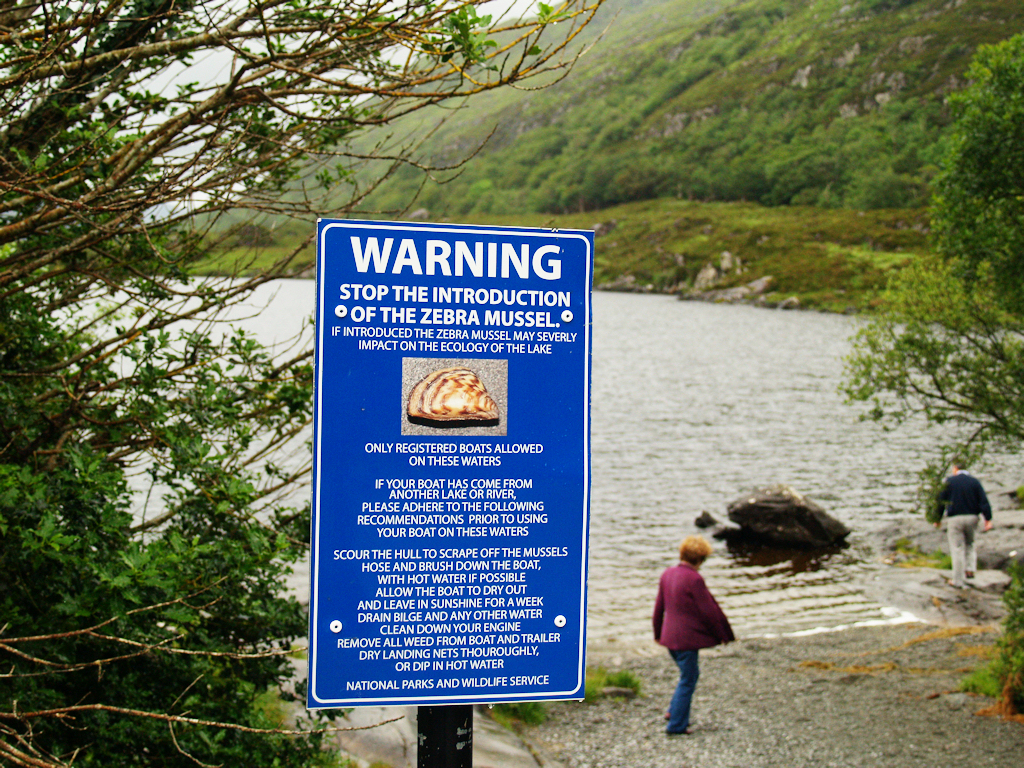The meridian line 100° west of Greenwich, England, often called simply the 100th Meridian, divides roughly the eastern side of North America from the west. This happens both geographically and culturally. So it cuts directly through the Great Plains in the United States.
It goes down the middle of North and South Dakota, through Nebraska, Kansas and Texas. It cleaves Oklahoma from its panhandle. Naturally a number of things came to mind when I discovered an organization called the 100th Meridian Initiative.
I’m not sure what I expected as I consulted the search engines while investigating meridians. Then I followed a link to their website out of simple curiosity. I’m positive I never would have guessed that they’ve focused exclusively on stopping the spread of invasive, non-native Zebra and Quagga Mussels throughout major North American waterways. But that’s exactly what it’s about, though.
Federal, state and local governments have drawn a figurative line-in-the-sand along the 100th Meridian in an attempt to halt the waterborne invasion. Their weapons include monitoring, reporting, education and a 24X7 national hotline staffed by a live person, 1-877-STOP-ANS. The “ANS” in that number refers to Aquatic Nuisance Species in case you were wondering. Whoever said the government wasn’t creative?
Origins

They’re serious. It’s a huge problem. Originally, Zebra Mussels originated near the Black Sea and Caspian Sea. Then they spread to the North American Great Lakes by 1988, probably in the ballast waters of freighters. The St. Lawrence seaway provides an easy, efficient conduit deep into the continental interior.
The Zebra’s close cousins the Quagga Mussels originated from the Dnieper River watershed of Ukraine. They arrived a year later. Now they’ve spread far and wide in southerly directions from the Great Lakes outward in just a couple of decades. It’s too cold outside of Carolinian Canada so its a problem confined primarily to the United States.
Impact

There are not enough predator species in these watersheds to keep intrusive mussel population in check. Mussels are filter-feeding mollusks. Billions of these tiny creatures, generally less than an inch across, will completely change a watershed. The newly-clarified rivers and lakes allow light to penetrate further into the depths. In turn, this allows certain aquatic plants to thrive in greater abundance. The results in completely unbalanced native ecosystems.
The mussels also attach to just about every surface available, often in large clusters. They clog water and power supply systems, ruin boat motors, and encrust shorelines. They’ve cause billions of dollars in damage to industrial and municipal infrastructure. They’ve also changed conditions for commercial fishing operations and amateur anglers alike.
The Challenge
The U.S. Fish & Wildlife Service has taken the lead in partnership with the University of Texas – Arlington to institute the 100th Meridian Initiative. It’s a race against time.
Unfortunately, once in motion, an invasive species with few predators runs rampant and finds ways to circumvent roadblocks. I’ve described that situation before on Twelve Mile Circle. Remember the apparent failure of the electric fish barriers on the Chicago River? Mankind started the mussel invasion and mankind contributes to its inexorable march across the continent in a modern-day Manifest Destiny in spite of noble efforts like those of the 100th Meridian Initiative.
Scientists learned the Quagga Mussels jumped the 100th Meridian by 2007. They discovered Quaggas in the Colorado River basin at Lake Mead, Lake Mohave and Lake Havasu. The vector was almost certainly a recreational boat. Someone probably pulled their pleasure craft from an infected area, didn’t inspect and clean it properly, and plopped it several hundred miles away in Arizona complete with live mussels attached.
These are impossibly tough mollusks. They can live several days or even weeks outside of water in the right conditions. That’s plenty of time to take an infested boat on a trailer from Lake Michigan to Lake Mead with living mussels attached that will survive the journey.
Increasing Awareness

Western states are cracking-down in an attempt to firewall their newly infected areas from pristine watersheds. Arizona requires boaters to clean, drain, dry and wait five days before putting a boat in another lake. They actually passed a law to that effect in March 2010. California, Nevada and Utah all allow law enforcement authorities to inspect boats being transported by trailer, too. Any vehicle with an Arizona license plate is considered probable cause.
However the spread may be inevitable. Utah officials believe they may have found a mature Quagga Mussel for the first time right before the Memorial Day 2010 holiday.
The invasion marches on.

Leave a Reply